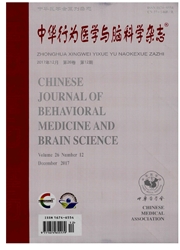

 中文摘要:
中文摘要:
目的 探讨原发性开角型青光眼患者的风险决策能力,分析原发性开角型青光眼患者的个性行为和人格特征。方法 选取原发性开角型青光眼患者27例和健康对照者30例,通过风险概率明确的骰子博弈测试(GDT)评价患者的风险决策能力。通过“A型行为问卷”和“艾森克人格问卷”(EPQ)了解患者的A型行为和人格特征。结果 与健康对照组比较,在GDT中,原发性开角型青光眼患者更倾向于做出冒险的决定,其负反馈利用率显著降低,差异有统计学意义(R:Z=-3.903,P=0.000;UOF:Z=-2.664,P=0.008)。原发性开角型青光眼患者中A型性格所占的比例和A型行为得分中CH、TH+CH得分值均高于健康对照组,差异有统计学意义(CH:t=3.06,P=0.003;TH+CH:Z=-2.621,P=0.009);TH得分差异无统计学意义。在EPQ测试中,青光眼组与健康对照组比较N、P得分差异有统计学意义(N:t=4.47,P=0.000;P:Z=-1.995,P=0.046)。结论与健康对照组比较,原发性开角型青光眼患者的风险决策能力有损害,表现为原发性开角型青光眼患者在决策中更倾向于高风险选择,存在明显的A型行为和神经质、精神质倾向的人格特征。
 英文摘要:
英文摘要:
Objective To investigate the ability of decision making under risky condition and personality characteristics in primary open - angle glaucoma patients. Methods A total of 27 primary open-angle glaucoma patients and 30 healthy controls were studied. Decision-making under risk was evaluated with Game of Dice Task (GDT). The Type A Behaviors Questionnaire and Eysenek Personality Questionnaire (EPQ) were used to evaluate the type A behaviors and personality characteristics of patients. Results Patients with primary open-angle glaucoma tended to make risky decisions significantly more often in GDT compared with healthy controls ( R : Z = - 3. 903 ). The utiliza- tion rate of negative feedback in GDT was significantly lower in glaucoma patients ( UOF : Z = - 2. 664, P = 0. 008 ). The proportion of type A personality in patients with primary open-angle glaucoma and type A behaviors score of CH, TH + CH scores were higher than the healthy controls ( CH : t = 3.06, P = 0. 003 ; TH + CH : Z = - 2. 621, P = 0. 009). Personality characteristics N, P scale scores in EPQ of patients with primary open-angle glaucoma were higher than the healthy controls ( N : t = 4.47, P = 0. 000 ; P : Z = - 1. 995, P = 0. 046 ). Conclusion Primary open- angle glaucoma patients exhibit impaired decision-making under risky condition. The performance of primary openangle glaucoma patients prefers to make risky choices. It also has a typical type A behaviors and personality traits of neuroticism and psychoticism.
 同期刊论文项目
同期刊论文项目
 同项目期刊论文
同项目期刊论文
 How does emotional context modulate response inhibition in alexithymia: electrophysiological evidenc
How does emotional context modulate response inhibition in alexithymia: electrophysiological evidenc External error monitoring in subclinical obsessive-compulsive subjects: electrophysiological evidenc
External error monitoring in subclinical obsessive-compulsive subjects: electrophysiological evidenc 期刊信息
期刊信息
